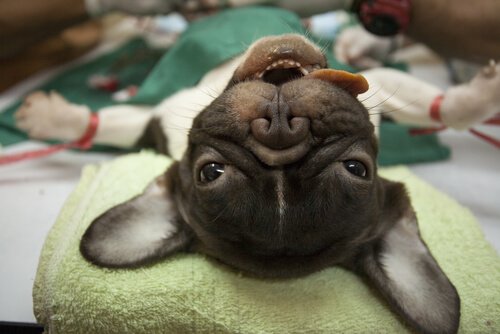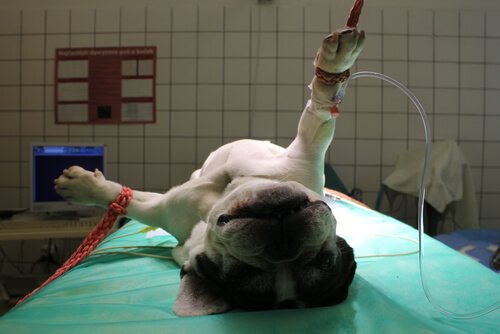Types of Anesthesia for Pets

Written and verified by the lawyer Francisco María García
Anesthesia is the application of medication to avoid the sensation of pain. Veterinarians use this procedure for performing various surgical operations in domestic animals. They also use it to keep aggressive animals still, and even for performing tests like X-rays and endoscopies.
The application of anesthesia is different for each animal. It depends on a number of factors, such as species, age, weight, size, breed, and pre-existing diseases.
Before Applying Anesthesia in Pets
Before giving an animal any type of medication, doctors run a series of procedures to determine the type of protocol they would use. Also, they make sure that the pet’s body is in good condition. Remember that some animals should not be anesthetized.
To obtain the necessary information before applying anesthesia, doctors will run:
- A complete blood test
- An electrocardiogram
- A complete and detailed physical examination

Types of Anesthesia for Pets
Basically, there are two types of anesthesia for pets:
Local Anesthesia
Local anesthetics are substances that, when applied to nerve tissue with proper concentrations, it will alleviate pain. It’s the least-used type of anesthesia.
Local anesthesia produces a soothing effect by obstructing the sending of sensory nerve impulses, from the receptor to the cerebral cortex. The vet applies it to a specific area. They use this type of anesthesia in local procedures and operations.
The substances that make up local anesthesia initially go to the bloodstream and are eliminated after a period of time. Unlike general anesthesia, they don’t cause unconsciousness.
This type of anesthesia is temporary. However, it does have some risks. Some risks factors are age, acid-base status, hepatitis, or cirrhosis and malnutrition.
General Anesthesia
This type of anesthesia is the most common one. Its effects are the foundation of general anesthesia. These effects are:
- Hypnosis: a “dream” state, the loss of consciousness
- Analgesia: A loss of sensitivity. The animal feels no pain.
- Muscle relaxation: mobility loss.
- Reflex loss: the loss of involuntary movement
- Amnesia: the animal won’t remember the operation.
Note that an animal must fast before receiving this type of anesthesia. Also, the more painful the procedure, the more anesthesia is required. This anesthesia allows the veterinarian to do his work best work. If the animal moves or bites the tools, the specialist won’t have the peace of mind needed to operate accurately.
General anesthesia is used for important operations like castration or sterilization, fractures, emergency surgeries, serious wounds, and even for dental problems. That’s because this type of anesthesia for pets protects their respiratory pathways.
In general, the risks of anesthesia for pets are low. However, in some cases you should consider whether these risks are greater than the benefits of the surgery.

Stages of General Anesthesia for Pets
Phase 1: Premedication
This phase consists of the application of muscle-relaxing drugs in order for the animal not to feel any pain. They start with this medication so the animal calms down and is less stressed. It also allows the next doses of medication to be lower and greater smoothness during the recovery phase.
Phase 2: Induction to Anesthesia
In this stage, doctors insert a catheter, that will stay there throughout the procedure to allow the application of intravenous drugs. The animal is completely asleep at this stage. This facilitates endotracheal intubation, by using anesthetic gases and oxygen flow.
Surgeons usually apply a mask to vaporize the gases. This mask is transparent so that the airways are always visible.
Phase 3: Maintenance
This is the stage when the surgery is performed, which is the most crucial moment. The anesthetic gases and oxygen will continue flowing during the entire operation because they will keep the animal asleep.
Phase 4: Recovery
The final phase is meant to stop the flow of anesthetic gases. Only oxygen continues to flow. They remove the endotracheal tube very carefully and wait until the animal wakes up. Remember that you should never leave the pet alone because they must be supervised at all times.
This text is provided for informational purposes only and does not replace consultation with a professional. If in doubt, consult your specialist.